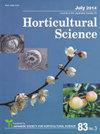Improved Accuracy in Determining Optimal Harvest Time for Pitaya ( Hylocereus undatus ) Using the Elasticity Index
Journal of The Japanese Society for Horticultural Science
Pub Date : 2013-10-01
DOI:10.2503/JJSHS1.82.354
引用次数: 12
Abstract
This study was conducted to determine whether the optimal harvest time of pitaya (Hylocereus undatus) could be identified more accurately using the elasticity index as determined by a nondestructive resonant-vibration method. Seven-year-old pitaya grown in beds filled with sand in an unheated greenhouse were used, and pollinated fruit in July (Jul.-PF) and September (Sep.-PF) were harvested at intervals of 4 days during days 20–36 or 20– 40 days, respectively, after anthesis. The second resonant frequency, the elasticity index, and flesh firmness decreased with ripening; however, values for Jul.-PF decreased faster than those for Sep.-PF. During the final harvest time, both groups of pollinated fruits had similar values for second resonant frequency (330 Hz), the elasticity index (60 × 10), and flesh firmness (7 N·cm). The a-value of peel color for Jul.-PF and Sep.-PF increased rapidly during days 24–32 and 28–36, respectively, after anthesis and thereafter showed almost constant values. Total sugar content in Jul.-PF increased rapidly until 28 days after anthesis and then increased slightly. Total sugar content in Sep.-PF increased later than in Jul.-PF. Organic acid in Jul.-PF and Sep.-PF decreased rapidly until 28 and 36 days, respectively, after anthesis and thereafter decreased slowly. In Sep.-PF that were harvested at the optimal time, the second resonant frequency declined as fruit size increased, but the elasticity index was not affected by fruit size. High positive correlations were found among the second resonant frequency, the elasticity index, and flesh firmness in both groups of pollinated fruit. Considering a comprehensive suite of parameters including pulp rate, peel color, sugar, organic acid, flesh firmness, and occurrence of cracking, the optimal harvest time was estimated to be 36 and 40 days after anthesis for Jul.-PF and Sep.-PF, respectively, and the elasticity index of fruit at optimal harvest time was 62 × 10 and 73 × 10, respectively. This study showed that the optimal harvest time of pitaya could be determined more accurately by measuring the elasticity index of on-tree fruit.利用弹性指数提高火龙果最佳采收期的准确性
利用非破坏性共振振动法测定的弹性指数,确定火龙果(Hylocereus undatus)的最佳采收期是否能更准确地确定。采用7年生火龙果,在不加热的温室中填满沙子,在7月(7 - pf)和9月(9 - pf)开花后20 - 36天和20 - 40天,每隔4天收获一次授粉的果实。第二共振频率、弹性指数和果肉紧致度随成熟而降低;但是,7 - pf的值比9 - pf下降得更快。在最终收获时,两组授粉后的果实在二次共振频率(330 Hz)、弹性指数(60 × 10)和果肉硬度(7 N·cm)方面具有相似的值。7 - pf和9 - pf的果皮颜色a值分别在开花后24-32天和28-36天迅速增加,此后基本保持不变。7 - pf总糖含量在花后28 d迅速上升,随后略有上升。9 - pf总糖含量比7 - pf增加晚。7 - pf和9 - pf有机酸分别在开花后28天和36天迅速下降,之后下降缓慢。在最佳采收时间采摘的9 - pf中,第二共振频率随果实大小的增加而下降,但弹性指数不受果实大小的影响。两组授粉后果实的二次共振频率、弹性指数和果肉硬度呈高度正相关。综合考虑果浆率、果皮颜色、含糖量、有机酸、果肉硬度、开裂率等参数,得出7 - pf和9 - pf的最佳采收期分别为开花后36天和40天,最佳采收期果实弹性指数分别为62 × 10和73 × 10。研究表明,通过测定火龙果在树上的弹性指数,可以更准确地确定火龙果的最佳采收期。
本文章由计算机程序翻译,如有差异,请以英文原文为准。
求助全文
约1分钟内获得全文
求助全文
来源期刊
自引率
0.00%
发文量
0
审稿时长
>36 weeks

 求助内容:
求助内容: 应助结果提醒方式:
应助结果提醒方式:


